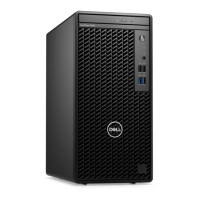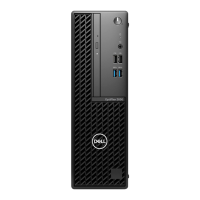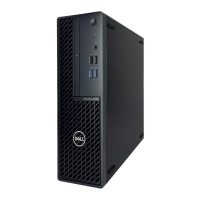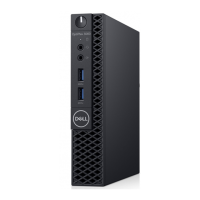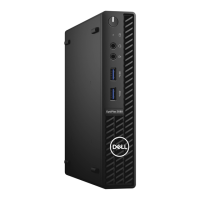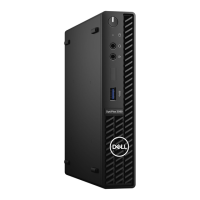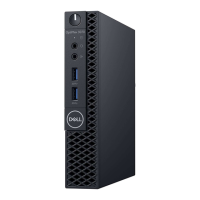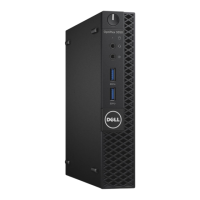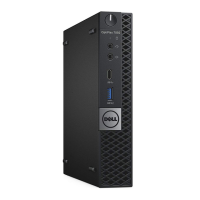What to do if my Dell Desktop has LCD failure (EC detection of power rail failure)?
- TThomas ZimmermanSep 10, 2025
Replace the system board.
What to do if my Dell Desktop has LCD failure (EC detection of power rail failure)?
Replace the system board.
What to do if my Dell OptiPlex 3000 Micro Desktop says no memory/RAM detected?
Confirm that the memory module is installed properly. If the problem persists, replace the memory module.
What to do if my Dell OptiPlex 3000 Micro Desktop has Memory/RAM failure?
Reset and swap memory modules among the slots. If the problem persists, replace the memory module.
What to do if my Dell OptiPlex 3000 Micro has Invalid memory installed?
Reset and swap memory modules among the slots. If the problem persists, replace the memory module.
What to do if my Dell OptiPlex 3000 Micro has System board failure (included BIOS corruption or ROM error)?
Flash latest BIOS version. If the problem persists, replace the system board.
What to do if my Dell OptiPlex 3000 Micro has BIOS Recovery image not found?
Flash latest BIOS version. If the problem persists, replace the system board.
What to do if my Dell OptiPlex 3000 Micro Desktop has Generic catch-all for ungraceful EC code flow errors?
Disconnect all power sources (AC, battery, coin cell) and drain flea power by pressing and holding down the power button for 3~5 seconds.
What to do if my Dell OptiPlex 3000 Micro has TPM detection failure?
Replace the system board.
How to fix LCD failure (SBIOS message) on Dell Desktop?
Replace the LCD module.
What to do if my Dell OptiPlex 3000 Micro Desktop has PCI or Video card/chip failure?
Replace the system board.
General safety guidelines and precautions before performing any computer service procedures.
Procedures and equipment to prevent damage from electrostatic discharge to components.
Guidelines for handling sensitive components and post-service procedures.
Warning regarding BitLocker impact when updating BIOS, requiring recovery key.
Procedures for removing and installing the computer's side cover and front bezel.
Instructions for servicing storage drives (SSD/HDD) and memory modules.
Steps for removing and installing the processor and its associated heat sink.
Detailed steps for safely removing and installing the main system board.
How to enter the BIOS setup utility and use navigation keys for configuration.
Overview of system settings related to boot, devices, storage, display, and network.
Step-by-step guides for updating the system BIOS via Windows or USB drive.
Guidance on setting, changing, and clearing system and setup passwords for security.
Using Dell SupportAssist for pre-boot system performance checks and understanding diagnostic lights.
Procedures for recovering the operating system and resetting the Real Time Clock (RTC).
Steps to resolve WiFi connectivity issues, including performing a WiFi power cycle.
List of online resources and tools for self-support and product information.
Information on how to contact Dell for sales, technical support, and customer service.
General safety guidelines and precautions before performing any computer service procedures.
Procedures and equipment to prevent damage from electrostatic discharge to components.
Guidelines for handling sensitive components and post-service procedures.
Warning regarding BitLocker impact when updating BIOS, requiring recovery key.
Procedures for removing and installing the computer's side cover and front bezel.
Instructions for servicing storage drives (SSD/HDD) and memory modules.
Steps for removing and installing the processor and its associated heat sink.
Detailed steps for safely removing and installing the main system board.
How to enter the BIOS setup utility and use navigation keys for configuration.
Overview of system settings related to boot, devices, storage, display, and network.
Step-by-step guides for updating the system BIOS via Windows or USB drive.
Guidance on setting, changing, and clearing system and setup passwords for security.
Using Dell SupportAssist for pre-boot system performance checks and understanding diagnostic lights.
Procedures for recovering the operating system and resetting the Real Time Clock (RTC).
Steps to resolve WiFi connectivity issues, including performing a WiFi power cycle.
List of online resources and tools for self-support and product information.
Information on how to contact Dell for sales, technical support, and customer service.
| Processor Options | 12th Gen Intel Core i3/i5/i7 |
|---|---|
| Memory | Up to 64GB DDR4 |
| Storage Options | Up to 1TB PCIe NVMe SSD |
| Graphics | Intel UHD Graphics |
| Operating System | Windows 11 Pro |
| Ports (Front) | 1 USB 3.2 Gen 1 Type-C port |
| Ports (Rear) | 2 x USB 3.2 Gen 1, 2 x USB 2.0, 1 x RJ-45 |
| Networking | Intel Wi-Fi 6 |
| Dimensions | 178 x 178 x 36 mm |
